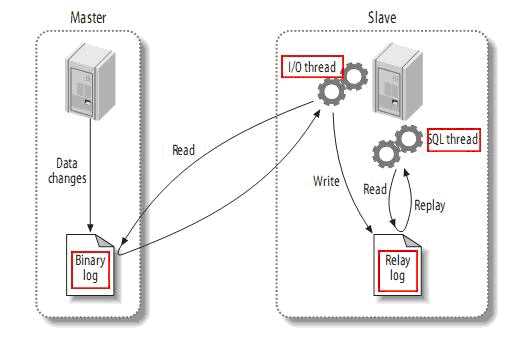标签:this aop spring 自定义 处理 解决 java 需要 row
大量的JavaWeb应用做的是IO密集型任务, 数据库的压力较大, 需要分流
大量的应用场景, 是读多写少, 数据库读取的压力更大
一个很自然的思路是使用一主多从的数据库集群: 一个是主库,负责写入数据;其它都是从库,负责读取数据. 主从库数据同步.
mysql原生支持主从复制

mysql主(称master)从(称slave)复制的原理:
1、master将数据改变记录到二进制日志(bin log)中, 这些记录叫binary log events
2、slave将master的binary log events拷贝到它的中继日志(relay log)
3、slave重做中继日志中的事件, 将改变反映它自己的数据(数据重演)
解决读写分离的方案大致有两种:
1)在应用层给读/写分别指定数据库
好处是数据源切换方便, 不用引入其他组件. 但是不能动态添加数据源.
2)使用中间件解决
好处是源程序不需要做任何改动, 还可以动态添加数据源. 但中间件会带来一定的性能损失.
目前有mysql-proxy, mycat, altas等
主库配置
修改my.ini:
#开启主从复制,主库的配置
log-bin = mysql3306-bin
#指定主库serverid
server-id=101
#指定同步的数据库,如果不指定则同步全部数据库
binlog-do-db=mydb
执行以下SQL:
SHOW MASTER STATUS;

记录下Position值,需要在从库中设置同步起始值。
#授权从库用户slave01使用123456密码登录本库
grant replication slave on *.* to ‘slave01‘@‘127.0.0.1‘ identified by ‘123456‘;
flush privileges;
从库配置
修改my.ini:
#指定serverid
server-id=102
执行以下SQL:
CHANGE MASTER TO
master_host=‘127.0.0.1‘,
master_user=‘slave01‘,
master_password=‘123456‘,
master_port=3306,
master_log_file=‘mysql3306-bin.000006‘, #设置主库时记下的Position
master_log_pos=1120;
#启动slave同步
START SLAVE;
#查看同步状态 Slave_IO_Running和Slave_SQL_Running都为Yes说明同步成功
SHOW SLAVE STATUS;
这里采用的是应用层的读写分离方案
使用AOP, 在执行Service方法前判断,是使用写库还是读库
可以根据方法名作为依据判断,比如说以query、find、get等开头的就走读库,其他的走写库
切面类:
/** * 如果在spring配置了事务的策略,则标记了ReadOnly的方法用从库Slave, 其它使用主库Master。 * 如果没有配置事务策略, 则采用方法名匹配, 以query、find、get开头的方法用Slave,其它用Master。 */ public class DataSourceAspect { private List<String> slaveMethodPattern = new ArrayList<String>(); //保存有readonly属性的带通配符方法名 private static final String[] defaultSlaveMethodStartWith = new String[]{"query", "find", "get" }; private String[] slaveMethodStartWith; //保存有slaveMethodStartWith属性的方法名头部 //注入 public void setTxAdvice(TransactionInterceptor txAdvice) throws Exception { if (txAdvice == null) { // 没有配置事务策略 return; } //从txAdvice获取策略配置信息 TransactionAttributeSource transactionAttributeSource = txAdvice.getTransactionAttributeSource(); if (!(transactionAttributeSource instanceof NameMatchTransactionAttributeSource)) { return; } //使用反射技术获取到NameMatchTransactionAttributeSource对象中的nameMap属性值 NameMatchTransactionAttributeSource matchTransactionAttributeSource = (NameMatchTransactionAttributeSource) transactionAttributeSource; Field nameMapField = ReflectionUtils.findField(NameMatchTransactionAttributeSource.class, "nameMap"); nameMapField.setAccessible(true); //设置该字段可访问 //获取nameMap的值 Map<String, TransactionAttribute> map = (Map<String, TransactionAttribute>) nameMapField.get(matchTransactionAttributeSource); //遍历nameMap for (Map.Entry<String, TransactionAttribute> entry : map.entrySet()) { if (!entry.getValue().isReadOnly()) { // 定义了ReadOnly的策略才加入到slaveMethodPattern continue; } slaveMethodPattern.add(entry.getKey()); } } // 切面 before方法 public void before(JoinPoint point) { // 获取到当前执行的方法名 String methodName = point.getSignature().getName(); boolean isSlave = false; if (slaveMethodPattern.isEmpty()) { // 没有配置read-only属性,采用方法名匹配方式 isSlave = isSlaveByMethodName(methodName); } else { // 配置read-only属性, 采用通配符匹配 for (String mappedName : slaveMethodPattern) { if (isSlaveByConfigWildcard(methodName, mappedName)) { isSlave = true; break; } } } if (isSlave) { // 标记为读库 DynamicDataSource.markMaster(true); } else { // 标记为写库 DynamicDataSource.markMaster(false); } } // 匹配以指定名称开头的方法名, 配置了slaveMethodStartWith属性, 或使用默认 private Boolean isSlaveByMethodName(String methodName) { return StringUtils.startsWithAny(methodName, getSlaveMethodStartWith()); } // 匹配带通配符"xxx*", "*xxx" 和 "*xxx*"的方法名, 源自配置了readonly属性的方法名 protected boolean isSlaveByConfigWildcard(String methodName, String mappedName) { return PatternMatchUtils.simpleMatch(mappedName, methodName); } // 注入 public void setSlaveMethodStartWith(String[] slaveMethodStartWith) { this.slaveMethodStartWith = slaveMethodStartWith; } public String[] getSlaveMethodStartWith() { if(this.slaveMethodStartWith == null){ // 没有配置slaveMethodStartWith属性,使用默认 return defaultSlaveMethodStartWith; } return slaveMethodStartWith; } }
Spring的RoutingDataSource
/** * 使用Spring的动态数据源,需要实现AbstractRoutingDataSource * 通过determineCurrentLookupKey方法拿到识别key来判断选择读/写数据源 * token显然是多例的, 所以引入ThreadLocal保存 */ public class DynamicDataSource extends AbstractRoutingDataSource { // 读库总数 private Integer slaveCount; // 读库轮询计数, 初始为-1, 本类为单例, AtomicInteger线程安全 private AtomicInteger counter = new AtomicInteger(-1); // 存储读库的识别key sl1ve01, slave02... 写库识别key为master private List<Object> slaveDataSources = new ArrayList<Object>(); //当前线程的写库/读库token private static final ThreadLocal<Boolean> tokenHolder = new ThreadLocal<>(); public static void markMaster(boolean isMaster){ tokenHolder.set(isMaster); } @Override protected Object determineCurrentLookupKey() { if (tokenHolder.get()) { return "master"; // 写库 } // 轮询读库, 得到的下标为:0、1、2... Integer index = counter.incrementAndGet() % slaveCount; if (counter.get() > 99999) { // 以免超出Integer范围 counter.set(-1); } return slaveDataSources.get(index); } @Override public void afterPropertiesSet() { super.afterPropertiesSet(); // 父类的resolvedDataSources属性是private, 需要使用反射获取 Field field = ReflectionUtils.findField(AbstractRoutingDataSource.class, "resolvedDataSources"); field.setAccessible(true); // 设置可访问 try { Map<Object, DataSource> resolvedDataSources = (Map<Object, DataSource>) field.get(this); // 读库数等于dataSource总数减写库数 this.slaveCount = resolvedDataSources.size() - 1; for (Map.Entry<Object, DataSource> entry : resolvedDataSources.entrySet()) { if ("master".equals(entry.getKey())) { continue; } slaveDataSources.add(entry.getKey()); } } catch (Exception e) { e.printStackTrace(); } } }
spring配置文件
<!-- 定义事务策略 --> <tx:advice id="txAdvice" transaction-manager="transactionManager"> <tx:attributes> <!--所有以query开头的方法都是只读的 --> <tx:method name="query*" read-only="true" /> <!-- readonly属性 --> <!--其他方法使用默认事务策略 --> <tx:method name="*" /> </tx:attributes> </tx:advice> <!-- 定义AOP切面处理器 --> <bean class="com.zx.DataSourceAspect" id="dataSourceAspect"> <!-- 注入事务策略 --> <property name="txAdvice" ref="txAdvice"/> <!-- 指定slave方法的前缀(非必须) --> <property name="slaveMethodStartWith" value="query,find,get"/> </bean> <aop:config> <aop:pointcut id="myPointcut" expression="execution(* com.zx.service.*.*(..))" /> <!-- 将切面应用到自定义的切面处理器上,-9999保证该切面优先级最高执行 --> <aop:aspect ref="dataSourceAspect" order="-9999"> <aop:before method="before" pointcut-ref="myPointcut" /> </aop:aspect> </aop:config> <!-- 定义数据源,继承了spring的动态数据源 --> <bean id="dataSource" class="com.zx.DynamicDataSource"> <!-- 设置多个数据源 --> <property name="targetDataSources"> <map key-type="java.lang.String"> <!-- 这些设置的key和determineCurrentLookupKey方法拿到的key相比对, 根据匹配选择数据源 --> <entry key="master" value-ref="masterDataSource"/> <!-- value-ref指向数据源 --> <entry key="slave01" value-ref="slave01DataSource"/> <entry key="slave02" value-ref="slave02DataSource"/> <entry key="slave03" value-ref="slave03DataSource"/> </map> </property> <!-- 设置默认的数据源,这里默认走写库 --> <property name="defaultTargetDataSource" ref="masterDataSource"/> </bean>
标签:this aop spring 自定义 处理 解决 java 需要 row
原文地址:http://www.cnblogs.com/myJavaEE/p/6682265.html